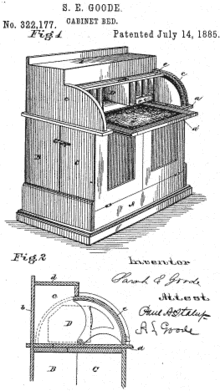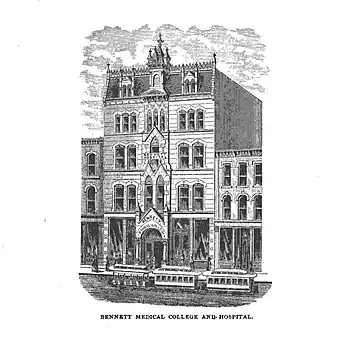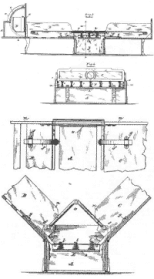Sarah E. Goode | |
|---|---|
| Born | Sarah Elizabeth Goode 1855 Toledo, Ohio, US |
| Died | April 8, 1905 (aged 50) |
| Occupation(s) | Inventor and entrepreneur |
| Known for | One of the first African-American women to receive a United States patent |
Sarah Elisabeth Goode (1855 – April 8, 1905) was an American entrepreneur and inventor. She was one of the first known African American women to receive a United States patent, which she received in 1885 for her cabinet bed.[1]
Biography

Born in 1855 in Toledo, Ohio to Oliver and Harriet (Kaufman) Jacobs, Goode was originally named Sarah Elisabeth Jacobs.[2][3] When she was young, her father worked as a waiter, and her mother kept the house.[4] Her mother also served as an organizer for the Ohio Anti-Slavery Society in Toledo,[5] which was a stop on the Underground Railroad.[6] Little is known about Goode’s early life, but before 1870, Goode’s family moved to Chicago, Illinois, and her father began working in carpentry.[7] There, she married Archibald Goode and had children with him.[8] Their known children are daughters Estella,[9] Inza (or Inez),[10] Harriet (Hattie),[11] Edna,[12] and Sarah Goode.[13] Archibald worked as a stair builder and an upholsterer, and he and Sarah opened a furniture store.[14]
Invention and furniture store years

In 1885, Sarah and her husband operated a furniture store at 513 State Street in Chicago.[15] The space was located at Bennett Medical College of Eclectic Medicine and Surgery which housed the storefront.[16] A Chicago Tribune article from September 1884 mentioned that S E Goode was exhibiting her French Flat Folding-Bed at the 32nd Annual Illinois State Fair.[17] She had sent in her invention paperwork with the help of attorney George P. Barton of Chicago in November of 1883. It would be $35 in fees and twenty months of waiting, getting rejected, making adjustments, and resubmitting before she would finally receive the patent.[1] By 1887, that furniture store was no longer on record. However, there was a furniture listing under Archie's name further down State Street.[18]
Concept of the folding bed
Most customers of Goode's furniture store were working-class people who lived in small apartments that couldn’t fit a lot of furniture, including beds.[19] As well as this, at the time of her invention, New York City passed a law that restricted buildings to be under 80 feet. Tenement buildings were also restricted to footprints of 25 feet by 100 feet.[20] As Goode heard this problem from her customers in Chicago, she set out to help Chicago apartment dwellers with limited space in their apartments.[21] Goode invented a folding bed that would become the precursor to the Murphy Bed - a hide-away bed. It was a cabinet bed which folded into a roll-top desk which had compartments for writing supplies and stationery.[22] Her goal for was to balance the weight of the folding of the bed so it could be easily lifted up and held in its place and also provide supplementary support to the center of the bed when it was unfolded.[23] In 1885, for her invention of the folding bed, Goode was one of the first African American women to receive a US patent.[24] The patented folding bed would inspire the modern-day Murphy bed.[25]
 Cabinet bed patent diagram. The bed folds down to create space.
Cabinet bed patent diagram. The bed folds down to create space.
Early patents among African American women
Sarah E. Goode was the fourth African American woman known to have received a US patent. The first and second were Martha Jones of Amelia County, Virginia, for her 1868 corn-husker upgrade[26] and Mary Jones De Leon of Baltimore, Maryland, for her 1873 cooking apparatus.[27][28] Judy W. Reed’s dough roller was the third, patented in 1884,[29] one year before Sarah's cabinet bed.[28] The Patent Office did not ask applicants to specify race on patent applications, only for confirmation that the patentee was an American citizen.[30]
Historic barriers in the patent process
Until a few decades prior to Sarah's invention, African Americans faced several barriers when applying for patents. Initially, some masters allowed enslaved people to apply for patents, but masters retained ownership of the patent process and profits.[31] Originally free persons of color were said to have no federal obstacles to securing patents.[32] However, in 1857, the Dred Scott decision declared that African Americans, free or enslaved, were not citizens and thus could not hold office, vote, or secure patents.[33] The Black Codes were also in effect in many states into the 1860s and limited the ability of African Americans to own property and patents.[34] Following the American Civil War, African Americans were given equal rights under the law and officially became recognized as citizens, allowing them to again secure patents.[35] Historically, women faced challenges in the patent process as well. The 1790 federal patent process allowed “persons”, not just men, to seek patents federally. However, many states limited the patent and property rights of women, creating an obstacle. These limitations decreased starting in 1839 and over the following decades. However, limitations to higher education institutions that specialized in scientific training were still a barrier. Financial backing and informal patent assistance were also both limited when it came to women's inventions as compared to men's, making the process of attaining a patent more difficult.[36]
Sarah's later years

It’s unclear if Sarah worked on more inventions following her folding bed. However, her husband Archie’s invention of an automatic garbage box was praised by the Chicago Civic Federation and published in a local newspaper in 1895.[37] The Paris Exposition of 1900 featured a section called The Exhibit of American Negroes, organized by Thomas J. Calloway and W. E. B. Du Bois, with the help of Henry E. Baker's patent research.[38] Sarah E. Goode was one of four women identified in the exhibit's showcase of African American inventors.[39]
Legacy
Sarah Elisabeth Goode died in Chicago on April 18, 1905 and is buried at the city's Graceland Cemetery.[40][3] In 2012, the Sarah E. Goode STEM Academy, a science and math based school, was opened in south Chicago to honor her contributions to the world. The school focuses on science, technology, engineering, and math (STEM) to help prepare students for their future careers.[41] It is part of the Chicago Public Schools Urban Model High School (UMHS).[42]
Sarah E. Goode STEM Academy is also a P-TECH school which stands for Pathways in Technology Early College High School. Not only does P-TECH connect high school students to employment opportunities in promising fields, it also offers them the chance to take college courses while in high school and to earn credits toward both—a concept called dual enrollment.[43]
In popular culture
In 2019, author Vivian Kirkfield published a children’s book about Sarah’s life as an inventor, titled “Sweet Dreams, Sarah.”[44]
References
- 1 2 "322177 - Folding Beds - Sarah E. Goode". National Archives. 1885.
- ↑ Boyd, Herb (2016-07-14). "Inventor Sarah E. Goode, the first Black woman awarded a patent". New York Amsterdam News. Retrieved 2022-12-07.
- 1 2 "Sarah Elisabeth Jacobs Goode". Find a Grave.
- ↑ "1860 United States Federal Census of Toledo, Lucas, Ohio". Ancestry. 1860. p. 225.
- ↑ Proceedings of a Convention of the Colored Men of Ohio, Held in the City of Cincinnati, on the 23d, 24th, 25th and 26th days of November, 1858. Cincinnati, Ohio: Moore, Wilstach, Keys & Co., Printers. 1858. p. 26.
- ↑ Akalimat, Abdul; Patterson, Rubin (2019). Black Toledo: A Documentary History of the African American Experience in Toledo, Ohio. Haymarket Books. p. 15. ISBN 978-1608461554.
- ↑ "1870 United States Federal Census of Chicago Ward 2, Cook, Illinois". Ancestry. 1870. p. 129.
- ↑ "1880 United States Federal Census of Chicago Ward 2, Cook, Illinois". Ancestry. 1880. p. 43.
- ↑ "Milwaukee, Wisconsin, U.S., Marriages, 1838-1911, Certificate 1754". Ancestry. 1897.
- ↑ "Cook County, Illinois, U.S., Birth Certificates Index, 1871-1922, FHL Film Number 1287723". Ancestry. 1878.
- ↑ "Cook County, Illinois, U.S., Deaths Index, 1878-1922, FHL Film Number 1239854". Ancestry. 1910.
- ↑ "Illinois, U.S., Deaths and Stillbirths Index, 1916-1947, FHL Film Number 1926669". Ancestry. 1935.
- ↑ "Cook County, Illinois, U.S., Deaths Index, 1878-1922, FHL Film Number 1030914". Ancestry. 1886.
- ↑ "Sarah E. Goode (c.1855?-1905) •". 2010-11-05. Retrieved 2022-12-07.
- ↑ The Lakeside Annual Directory of the City of Chicago (PDF). Chicago, Illinois. 1885. p. 1625.
{{cite book}}: CS1 maint: location missing publisher (link) - ↑ Hoke, Samuel W. (1885). Eighteenth Annual Announcement of the Bennett Medical College of Eclectic Medicine and Surgery. Chicago, Illinois. p. 9.
{{cite book}}: CS1 maint: location missing publisher (link) - ↑ "Local and Exposition Notes". Chicago Tribune. September 21, 1884. p. 15.
- ↑ The Lakeside Annual Directory of the City of Chicago. Chicago, Illinois. 1887. p. 615.
{{cite book}}: CS1 maint: location missing publisher (link) - ↑ "Sarah E. Goode". Biography. 23 February 2021. Retrieved 2022-12-07.
- ↑ "Tenements". HISTORY. 10 October 2019. Retrieved 2022-12-07.
- ↑ Boyd, Herb (2016-07-14). "Inventor Sarah E. Goode, the first Black woman awarded a patent". New York Amsterdam News. Retrieved 2022-12-07.
- ↑ "Sarah E. Goode (c.1855?-1905) •". 2010-11-05. Retrieved 2022-12-07.
- ↑ Otha Richard Sullivan (2002). African American women scientists and inventors. Internet Archive. Wiley. ISBN 978-0-471-38707-7.
- ↑ "Sarah E. Goode". Clara Barton Museum. 2016-01-06. Retrieved 2022-12-07.
- ↑ "Sarah E. Goode". Biography. 23 February 2021. Retrieved 2022-12-07.
- ↑ "Patent US77494A, Improvement in corn-husker, sheller". 1868.
- ↑ "Patent US140253A, Improvement in cooking apparatus". 1873.
- 1 2 Holmes, Keith C. (2008). Black Inventors: Crafting Over 200 Years of Success. Brooklyn, New York: Global Black Inventor Research Projects, Inc. p. 90. ISBN 978-0-9799573-0-7.
- ↑ "Patent US305474A, Dough Kneader and Roller".
- ↑ Baker, Henry E. (1917). "The Negro in the Field of Invention". The Journal of Negro History. 2 (1): 23. doi:10.2307/2713474. JSTOR 2713474. S2CID 150137420.
- ↑ McKissack, Patricia; McKissack, Fredrick (1994). African-American Inventors. Brookfield, Connecticut: The Millbrook Press. p. 29. ISBN 1-56294-468-1.
- ↑ Baker, Henry E. (1917). "The Negro in the Field of Invention". The Journal of Negro History. 2 (1): 25. doi:10.2307/2713474. JSTOR 2713474. S2CID 150137420.
- ↑ McKissack, Patricia; McKissack, Fredrick (1994). African-American Inventors. Brookfield, Connecticut: The Millbrook Press. p. 33. ISBN 1-56294-468-1.
- ↑ Merritt, Deborah J. (1991). "Hypatia in the Patent Office: Women Inventors and the Law, 1865-1900". The American Journal of Legal History. 35 (3): 304. doi:10.2307/845974. JSTOR 845974.
- ↑ McKissack, Patricia; McKissack, Fredrick (1994). African-American Inventors. Brookfield, Connecticut: The Millbrook Press. p. 35. ISBN 1-56294-468-1.
- ↑ Merritt, Deborah J. (1991). "Hypatia in the Patent Office: Women Inventors and the Law, 1865-1900". The American Journal of Legal History. 35 (3): 289–290. doi:10.2307/845974. JSTOR 845974.
- ↑ "Box Empties its Garbage, New Invention Commended by the Civic Federation". The Inter Ocean. October 10, 1895. p. 8.
- ↑ James, Portia P. (1989). The Real McCoy: African-American Invention and Innovation, 1619-1930. United States: Smithsonian Institution Press. pp. 78–79. ISBN 0-87474-557-8.
- ↑ Sluby, Patricia Carter (2004). The Inventive Spirit of African Americans: Patented Ingenuity. Westport, Connecticut: Praeger Publishers. p. 130. ISBN 0-275-96674-7.
- ↑ Otha Richard Sullivan (2002). African American women scientists and inventors. Internet Archive. Wiley. ISBN 978-0-471-38707-7.
- ↑ Foroohar, Rana (2014-02-24). "The School That Will Get You a Job". Time. ISSN 0040-781X. Retrieved 2022-12-07.
- ↑ "PBC Chicago". PBC Chicago.
- ↑ Abdul-Alim, Jamaal (2022-08-28). "A Job and a College Degree Before You Graduate High School". Washington Monthly. Retrieved 2022-12-07.
- ↑ Kirkfield, Vivian (2019). Sweet Dreams, Sarah. Creston Books. ISBN 978-1939547316.